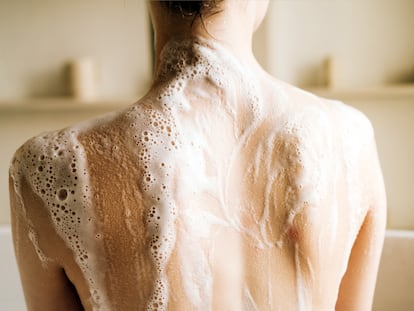Skin absorption rate, or why a beauty routine with a lot of steps can be counterproductive
Experts agree that the skin’s absorption capacity is not unlimited. So, does it make sense to perform a cosmetic routine focused on layering? Dermatologists set the record straight

Many experts shake their heads when they see cosmetics tutorials with lots of steps. The controversy lies in the so-called skin absorption rate, a concept that says that no matter how many cosmetics we use, the skin can only take in a limited amount of them. Is it true? Dr. Lía Fabiano, the director of the LF Clinic, explains that “the skin is not a sponge that can absorb everything you put on it. It absorbs only the amount of cream it needs; putting more on saturates it and is counterproductive. Excess product can lead to the obstruction of the pilosebaceous follicles and the appearance of congested skin and cosmetic acne. In addition, the more products you use, the more likely you are to have adverse reactions or to combine incompatible active ingredients. The benefits of cosmetics do not increase by applying more product or using a greater number of them. You have to take care of [your] skin based on what it needs with the right steps, products and quantities.” Lucía González, a dermatologist at GEDET and Dr. Morales Raya Clinic agrees: “The first thing to bear in mind is that cosmetics penetrate through the epidermis, which is the skin’s first layer. Some of them can even reach the dermis to act on collagen and elastin, but the reality is that they never penetrate beyond the superficial layers. So, applying layers and layers of products that the skin can’t absorb causes an occlusive effect that leads to acne breakouts and makes the cosmetic routine more expensive.”
What determines the skin no longer being able to absorb more product?
Skin permeability is the skin tissue’s ability to allow different cosmetic actives to penetrate it. “The more permeable it is, the more effective the routine will be. That’s why working on improving its permeability is essential. This does not mean that its absorption capacity is infinite, but rather that it is a matter of promoting the maximum permeability that each individual can achieve. Prepared skin is more receptive and tolerates layering [different products] better,” explains Estefanía Nieto, Omorovicza’s technical director. It is also important to understand how the products we use behave. “If we use watery textures, the skin can absorb a lot. Oily textures create a barrier effect that occludes the skin and does not allow it to absorb more,” Nieto explains.
Impenetrable skin: that is why cosmetics don’t have an effect. Has your skincare stopped working? It is important to dispel the myth that the skin gets used to cosmetics and stops working. “That doesn’t happen; it’s your skin that changes. Stress, for example, increases cortisol levels and alters the epidermis. It’s not that it has become accustomed to the cosmetic product, but rather that [the skin] needs other actives or textures that we are not giving it. But often the products do not work because of the impatience of the users who expect to see results on their skin after three days of use,” says Dr. Lía Fabiano.
But many people change their routine and don’t notice much difference. “That can happen because the new product has a very low concentration of active ingredients, or because you’ve been using more powerful cosmetics and a weaker one has no effect,” argues Elisabeth San Gregorio, Medik8′s technical director. One of the main reasons that products do not deliver what they promise is the skin’s permeability. Is your skin impermeable? “All skins allow some degree of penetration. Impermeable skin is so saturated that products can’t penetrate well; much of [the product] stays on the surface or even evaporates without being able to fulfill the purposes for which it is formulated,” says San Gregorio.
Can we improve our skin’s absorption rate?
It is possible to modify the absorption rate, but it is important to know that this depends on multiple factors. “Some products penetrate better than others. It depends on the size of the molecule, its concentration and texture. On the other hand, using products that thin the epidermis, such as hydroxy acids, or prepare it to increase its permeability, such as toners, is always a good strategy,” says Lucía González. Dr. Lía Fabiano explains that “the skin absorbs what it needs, nothing more. But there are certain skin care products that facilitate the penetration of active ingredients. Clean skin absorbs cosmetics better and regular exfoliation to remove dead cells from the stratum corneum are essential.”
5 ways to improve skin’s permeability
Yes, improving the receptivity of the epidermis is good for all skin types because you’ll notice a considerable improvement without having to change your routine. Products will penetrate better and deliver what they promise. Several experts tell us about the elements to consider:
1- Cleansing well: The lack of correct daily facial hygiene prevents good absorption of cosmetics. If we do not [cleanse properly], impurities are deposited on the surface, leaving the skin dull, saturated and with blackheads. “I recommend a double cleanse: start with an oily product to remove heavy textures, such as makeup and SPF, and then finish with a gel for deep cleansing. But be careful! This order should only be revered in cleansing, then always go from the wateriest to the thickest,” explains Raquel González, a cosmetologist and technical director for Perricone MD.
2- Exfoliation: Not renewing the skin leads to a layer of dead cells, which reduces permeability, leaving a dull tone and the appearance of damaged skin. “Acids gently exfoliate the skin’s surface layer, add luminosity, improve texture and allow the penetration of active ingredients because there are fewer obstacles to reaching the deep layers. Salicylic acid improves acne-prone skin and glycolic acid is good for treating the signs of aging. Each type of acid reacts in a certain way, and it is important to get a diagnosis and advice from a professional,” says Dr. Delia Vila of Regenera Clinic.
3- The 3-second rule: In Korea, there is a three-second rule for applying serums and moisturizers. It consists of leaving a three-second window after cleansing to spread the serum or cream with damp skin. “After washing the face, the pores are more open and the permeability of water-based serums and creams is improved with the moisture in the skin. In addition, when we cleanse the face, we remove excess oil from the skin. In the time between when this happens and when the sebum returns to balance, the oil barrier is not as strong, allowing for better penetration of active ingredients,” says Raquel Gonzalez, Perricone MD’s director of education.
4- The correct order for layering products: The most common reason that products do not penetrate is the order of application. “Cosmetics should be applied from lightest to thickest, starting with water-based formulas and ending with oil-based products. The skin barrier is composed of lipids and, if we start the routine with an oily product, we will reinforce that, creating a film that will prevent other cosmetics from penetrating,” Raquel Gonzále says. We should always apply products from watery to oily. “Toners and moisturizing serums rich in ingredients such as hyaluronic acid or niacinamide should always go first. After that, continue with products that are higher molecular weight. [They include] certain vitamin C serums, copper derivatives and peptides that address specific concerns. Finally, [there is] everything that serves to retain hydration such as shea butter, squalane or ceramides,” says Isabel Reverte, the Rosalique technical director.
5- Using the right amount: Using too much moisturizer can leave your face feeling greasy and potentially lead to breakouts. Dr. Delia Vila explains “the moisturizer should be applied in sufficient quantity, without oversaturating the skin…[It’s] better [done] with a light massage that promotes ]total absorption.” And what is the appropriate amount of product? “Generally, it would be the equivalent of a pea for the face or an almond, including the neck and décolleté. When it comes to spreading it, it is very important to do so with soft massages, without stretching the skin because this repetitive motion can cause wrinkles and sagging tissue. It should be done from the middle of the face to the chin from the inside out with small massages. On the forehead, [you should go] from the bottom upward, and on the neck, [use] upward movements,” Dr. Lía Fabiano of LF Clinic notes.
So, do routines with lots of steps make sense?
The Korean routine with multiple layers and products goes against some current trends such as cosmetic fasting and skinimalism. How can we choose the one that best suits our skin? “It depends on one’s lifestyle, skin type and specific needs. If there are many concerns to address, complete routines with a lot of steps are the best choice, as long as we prepare the skin to be able to absorb them,” says Raquel Gonzalez. On the other hand, people with skin that is saturated because they apply more product than they need “should opt for the law of less is more, although to get it right, it is always important to see a specialist to assess the skin’s condition,” Dr. Delia Vila notes.
Sign up for our weekly newsletter to get more English-language news coverage from EL PAÍS USA Edition
Tu suscripción se está usando en otro dispositivo
¿Quieres añadir otro usuario a tu suscripción?
Si continúas leyendo en este dispositivo, no se podrá leer en el otro.
FlechaTu suscripción se está usando en otro dispositivo y solo puedes acceder a EL PAÍS desde un dispositivo a la vez.
Si quieres compartir tu cuenta, cambia tu suscripción a la modalidad Premium, así podrás añadir otro usuario. Cada uno accederá con su propia cuenta de email, lo que os permitirá personalizar vuestra experiencia en EL PAÍS.
¿Tienes una suscripción de empresa? Accede aquí para contratar más cuentas.
En el caso de no saber quién está usando tu cuenta, te recomendamos cambiar tu contraseña aquí.
Si decides continuar compartiendo tu cuenta, este mensaje se mostrará en tu dispositivo y en el de la otra persona que está usando tu cuenta de forma indefinida, afectando a tu experiencia de lectura. Puedes consultar aquí los términos y condiciones de la suscripción digital.
More information
Últimas noticias
Most viewed
- Reinhard Genzel, Nobel laureate in physics: ‘One-minute videos will never give you the truth’
- Oona Chaplin: ‘I told James Cameron that I was living in a treehouse and starting a permaculture project with a friend’
- Pablo Escobar’s hippos: A serious environmental problem, 40 years on
- Why we lost the habit of sleeping in two segments and how that changed our sense of time
- Chevy Chase, the beloved comedian who was a monster off camera: ‘Not everyone hated him, just the people who’ve worked with him’










































